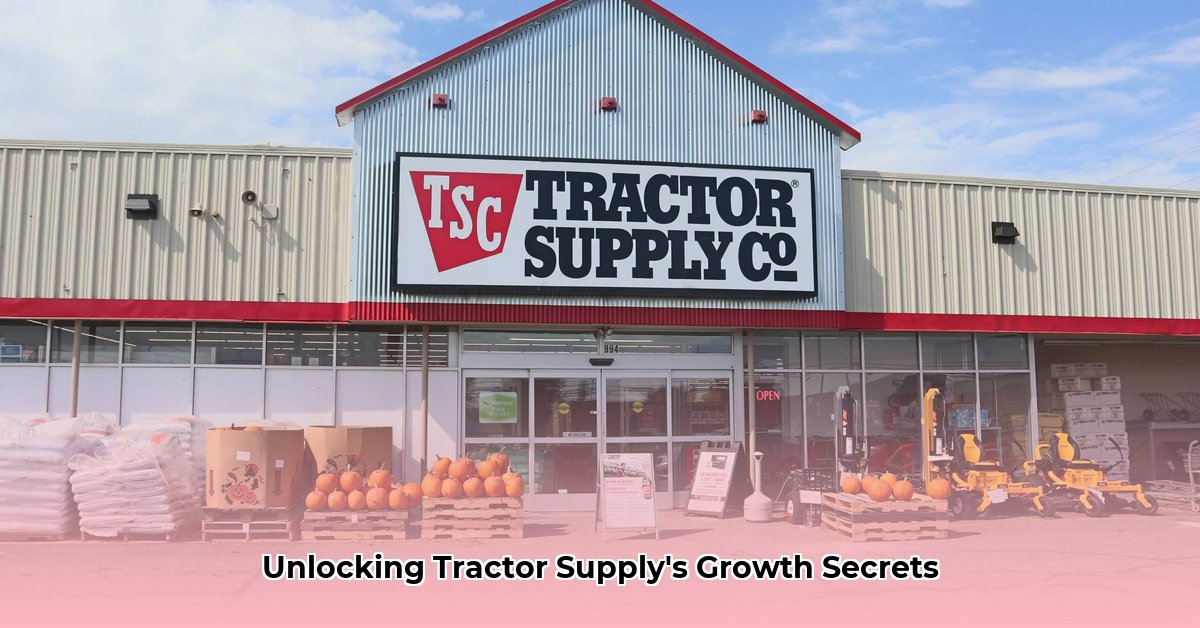
Tractor Supply Company (TSC) holds a significant position in the Massachusetts market, with its Millis store providing a valuable case study for understanding broader growth opportunities. This analysis examines TSC's competitive landscape, e-commerce performance, and strategies for enhanced growth, focusing on actionable steps for TSC management, local communities, and customers. For more examples of successful TSC stores, see this Carlisle, PA store example.
Understanding the Massachusetts Market
TSC caters to a diverse customer base in Massachusetts, encompassing both rural and suburban residents involved in farming, gardening, and home improvement. However, a comprehensive understanding of the market is crucial for optimizing growth strategies. How effectively does TSC's current approach satisfy the needs of this varied clientele? A thorough market analysis will illuminate opportunities, including underserved segments and specific regional preferences. This data-driven approach will guide strategic decision-making.
Competitive Landscape Analysis
TSC faces competition from various sources. Big-box retailers like Home Depot and Lowe's offer some overlapping products, but their broader focus creates differentiation opportunities for TSC. More direct competition comes from specialized agricultural suppliers. A detailed competitive analysis, incorporating market research and perhaps customer surveys, is needed to pinpoint TSC's competitive strengths (e.g., personalized service, specialized product selection, focus on rural needs). This analysis should also identify areas for improvement and strategic positioning, perhaps pinpointing geographic regions where TSC's market share could be strengthened.
The Digital Frontier: E-commerce and Online Sales
A robust online presence is critical for modern retail success. While data on Massachusetts TSC stores' online performance is currently limited, enhancing e-commerce represents a significant growth opportunity. Many customers prefer the convenience of online shopping for bulky items like feed or fencing, benefiting from home delivery or click-and-collect options. Improving the TSC website's user experience, including enhanced product descriptions, improved search functionality, streamlined checkout, and high-quality imagery, is paramount for increasing online sales conversion rates. This enhanced online experience should mirror the positive in-store experience. Does TSC currently offer a competitive online shopping experience compared to its competitors? This is a key question for further investigation.
Strategies for Growth: A Multi-pronged Approach
TSC's growth in Massachusetts requires a comprehensive strategy engaging TSC management, local communities, and customers. Here are actionable steps categorized by stakeholder:
Actionable Steps for TSC Management
Short-Term Goals (Within 1 Year):
- Optimize Store Hours: Analyze sales data to refine store hours, maximizing peak shopping periods and potentially improving employee scheduling efficiency.
- Niche Market Identification: Identify areas of specialization and offer unique goods or services to differentiate TSC from competitors.
- Inventory Management Upgrade: Implement advanced inventory management systems to reduce stockouts and ensure product availability.
- Enhance Online Experience: Improve website usability, including navigation, search functionality, and product descriptions.
Long-Term Goals (3-5 Years):
- Market Research for Expansion: Conduct thorough market research to identify optimal locations for new stores, focusing on underserved areas.
- Strategic Partnerships: Forge collaborations with local farmers and agricultural businesses to expand product offerings and enhance brand visibility.
- Comprehensive E-commerce Strategy: Develop a robust e-commerce strategy, incorporating website improvements, enhanced shipping options (including same-day delivery where feasible), and optimized mobile experiences.
- Click-and-Collect Implementation: Implement a convenient click-and-collect service for customers who prefer to order online and pick up in-store.
Opportunities for Local Community Engagement
Short-Term Collaboration:
- Community Events Participation: Participate actively in local events (farmers' markets, county fairs) to boost brand awareness and build community relationships.
- Workshops and Demonstrations: Host workshops or demonstrations on topics relevant to local agriculture or home improvement; this enhances brand loyalty and provides valuable customer service.
- Exceptional Customer Service: Provide consistently outstanding customer service to foster local loyalty and build a positive reputation.
Long-Term Community Engagement:
- Local Event Sponsorship: Sponsor local events or initiatives to strengthen community ties and demonstrate corporate social responsibility.
- Corporate Social Responsibility (CSR) Programs: Implement CSR initiatives benefiting the local environment or economy—demonstrating that TSC is a good neighbor as well as a reliable retailer.
- Building Strong Brand Loyalty: Focus on fostering deeper relationships with local residents, resulting in stronger long-term brand loyalty.
Empowering Customers: Enhancing the Shopping Experience
Short-Term Improvements:
- Enhanced Store Layout: Improve in-store layout and signage for better navigation and product visibility.
- Loyalty Programs: Introduce loyalty programs and discounts to reward repeat customers and encourage further purchasing.
- Seasonal Product Promotion: Highlight seasonal products relevant to local needs, timed with local events and demands.
Long-Term Customer Engagement:
- Personalized Recommendations: Use customer data to provide personalized shopping recommendations.
- Targeted Marketing: Implement targeted advertising campaigns to reach specific customer segments with relevant promotions.
- Feedback Systems Implementation: Create systems for collecting and analyzing customer feedback to continuously improve the shopping experience.
Data Visualization: Unlocking Key Insights
Effective decision-making requires data visualization. Maps showing store density relative to competitors, charts comparing market share, and graphs illustrating online sales trends would provide crucial insights. These visuals facilitate a clear and concise understanding of trends, allowing informed choices. For example, a heatmap showing store density overlaid with competitor locations would quickly reveal underserved areas ripe for expansion.
The Millis Store: A Case Study for Success
The Millis store provides a valuable case study for understanding TSC's strengths and weaknesses in Massachusetts. Analyzing its performance—both its successes and challenges—will yield valuable lessons and provide insights applicable to other locations. Understanding what contributes to the Millis store's success and identifying areas for improvement are crucial steps towards optimizing the performance of all Massachusetts stores.
Cultivating Future Growth: A Holistic Approach
TSC's future success in Massachusetts depends on a carefully crafted, holistic strategy. By combining a strong physical presence with a robust online presence, understanding the competitive landscape, focusing on customer needs, adapting to emerging market trends, and cultivating mutually beneficial relationships with local communities, TSC can achieve sustainable, long-term growth. The foundation laid by stores like the Millis location can be leveraged to build lasting success across the entire state.